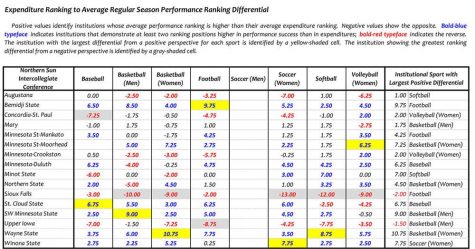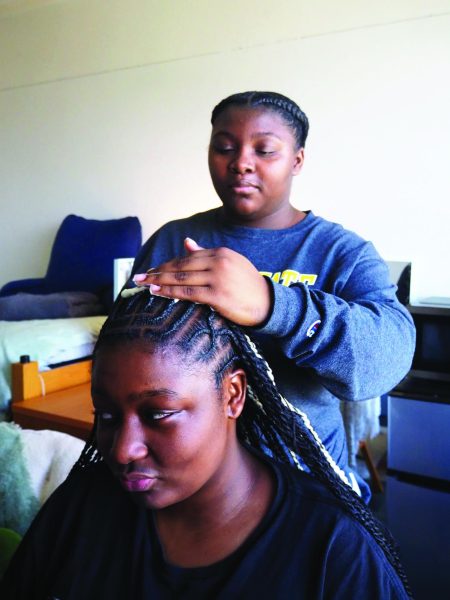The most bang for your buck
Report by NSIC shows Wayne State spends less, wins more
February 5, 2015
The saying goes, money doesn’t buy happiness.
The same can be said for athletics, too. An organization can spend tons and tons of money, yet not see any results on the field in terms of wins and losses.
As sports fans, we’ve all been there at some point. Our favorite sports team going out and getting a bunch of stars, throwing money at them, yet not having a championship to show for it.
In college athletics, the same principle can apply. Not necessarily in giving athletes money, but spending it in facilities, coaches and other expenditures.
In a sport-by-sport and comprehensive athletic program analysis distributed last fall by the Northern Sun Intercollegiate Conference that studies expenditures and performance for a four-year period from 2009-10 through 2012-13, Wayne State College outperformed their resources in every sport.
Wayne State ranked number one in efficiency of expenditures per success of the combination of regular season and postseason action of all sports. In terms of how much WSC spends, we rank 13th in the conference out of a total of 16 teams.
“Part of that is that we have a smaller athletic department,” Athletic Director Mike Powicki said. “But if you compare our numbers to other schools similar to our size, they still spend more but we have more success.”
Breaking it down into men’s and women’s categories, all of Wayne State’s men’s programs rank fifth in the conference while the women are ranked number one.
“It summarizes how much each institution spends on athletics and cross references that with overall athletic success in the regular season and the postseason,” Powicki said. “Every single program that Wayne State offers is at least two rankings higher in performance than what we spend.”
Essentially, Wayne State outperforms its resources in every sport offered. And it’s not even close.
Two other schools in the NSIC, Minnesota State-Moorhead and Winona State, can say the same. Upper Iowa, however, cannot. They are in the negative in every single sport that they offer, the closest to zero being men’s basketball, a program that current head coach Brian Dolan built before leaving.
Breaking it down by each individual sport, both women’s basketball and volleyball were ranked as the most efficient in the conference in their own category.
“It makes me feel good,” volleyball head coach Scott Kneifl said. “We try to be as cost efficient as we possibly can. But at the same time we try to treat our athletes well because they put in a lot of time and effort.
“Knowing that our sport does a good job at being cost efficient and succeeding says a lot about our program.”
Head Coach of the women’s basketball team Chris Kielsmeier had similar praise.
“It validates that we know what we’re doing as a program,” he said. “You need to approach your budget within your program as your own personal finance. You need to account for every dollar and when it isn’t being spent wisely that needs to be fixed immediately.
“It’s having a plan. We don’t do anything moneywise that we don’t have a plan for.”
This report can break it down even further. Going to the next level, the average institutional ranking of efficiency, performance and federal graduation rate are taken into consideration.
Wayne State slipped some, falling to fourth in the overall all-sport rank. However, women’s basketball held strong to the top spot in their category.
With everything else that a head coach has to handle and deal with, how much is the money factor an issue in day-to-day operations?
“It’s a lot more than people think. We feel fortunate our administrators give us what we feel we need to succeed,” Kneifl said. “Behind the scenes, it happens all the time. On road trips, you’re constantly going to restaurants or hotels and trying to find something that is cost efficient yet still nice at the same time.
“We talk about it a lot. We don’t want to go over budget, but we are fortunate that our budget is at a place where we feel we can succeed.”
According to Kielsmeier, a lot of time is spent going over every dime spent and it isn’t easy running a tight ship.
“I don’t know if it is day-to-day, but it is certainly week-to-week,” he said. “It is very time-consuming and I don’t think people see that side of it. If you are going to manage an extremely tight budget, you have to spend a lot of time managing it and we have other great people to help us do that.
“When it comes down to it, when you’re paying bills, you have to make sure that you’re spending that money wisely and running a tight ship.”
At some point, the question arises: How does Wayne State get away with so much success while not spending any money?
“It’s not an easy answer,” Powicki said. “It is a combination of a lot of things. The fact that WSC is a four-year, affordable school is part of it, as well as having great coaches, but it comes down to other faculty helping to bring student-athletes in and developing them, making them successful in the classroom and the competition.”
Each sport is provided money by the athletic department. They try to keep the numbers as even as possible, but there are some roadblocks.
“I think in operations we do a good job of funding all of our programs equally, and we give them what they need to operate throughout the year,” Powicki said. “A coach will give us their travel schedule for the upcoming year in the summer, and we have a formula we use to split it up.” It comes down to meals, lodging, charter buses and that is all mapped out before the school year.
Then, based on roster sizes, money will be divided out for recruiting and other operating costs.
“The college gives us our overall budget, then anything that we can’t get done with our operating budget we have to fundraise,” Powicki said.
Fundraising for operating costs can reach six figures, according to Powicki. This comes from when specific teams sell shirts, special events or anything else they do as a team.
As expected, there’s always an NCAA rule to dance around.
“More specifically, what you can provide a student athlete,” Powicki said. “You can buy their meals, travel for games, but it is strict on giving them anything else that’s not related to the team activities.”
However, NSIC rules are more focused on scholarship numbers and more procedural activities.
But when it comes down to it, is it all enough?
“I’ve never looked at it as what I don’t have, I look at it from a standpoint of what I have, and let’s make it work,” Kielsmeier said. “I’ve never allowed anyone in our program to worry about what we don’t have, but concentrate on what we do have, and find a way to make it work. That’s the way our program operates top to bottom.”
When it comes down to it for Wayne State athletic funds, less is more.










